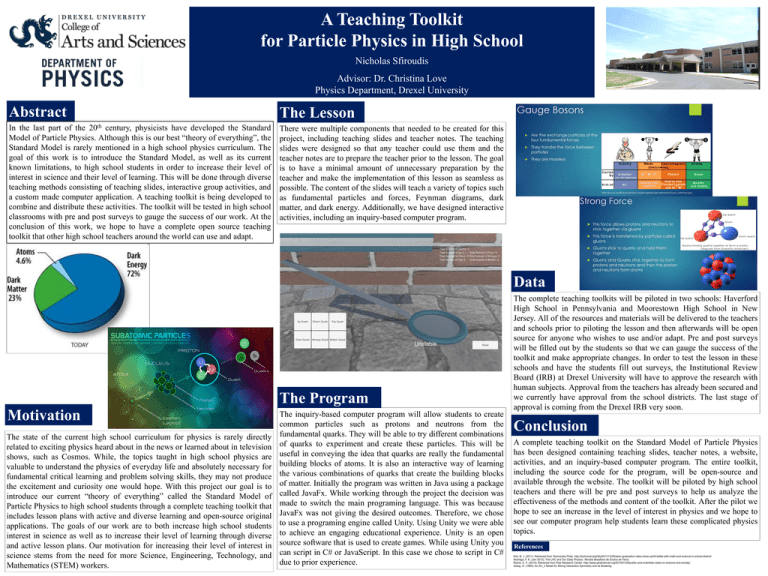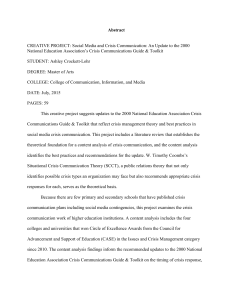A Teaching Toolkit for Particle Physics in High School Abstract The Lesson
advertisement

A Teaching Toolkit for Particle Physics in High School Nicholas Sfiroudis Advisor: Dr. Christina Love Physics Department, Drexel University Abstract The Lesson In the last part of the 20th century, physicists have developed the Standard Model of Particle Physics. Although this is our best “theory of everything”, the Standard Model is rarely mentioned in a high school physics curriculum. The goal of this work is to introduce the Standard Model, as well as its current known limitations, to high school students in order to increase their level of interest in science and their level of learning. This will be done through diverse teaching methods consisting of teaching slides, interactive group activities, and a custom made computer application. A teaching toolkit is being developed to combine and distribute these activities. The toolkit will be tested in high school classrooms with pre and post surveys to gauge the success of our work. At the conclusion of this work, we hope to have a complete open source teaching toolkit that other high school teachers around the world can use and adapt. There were multiple components that needed to be created for this project, including teaching slides and teacher notes. The teaching slides were designed so that any teacher could use them and the teacher notes are to prepare the teacher prior to the lesson. The goal is to have a minimal amount of unnecessary preparation by the teacher and make the implementation of this lesson as seamless as possible. The content of the slides will teach a variety of topics such as fundamental particles and forces, Feynman diagrams, dark matter, and dark energy. Additionally, we have designed interactive activities, including an inquiry-based computer program. Data The Program Motivation The state of the current high school curriculum for physics is rarely directly related to exciting physics heard about in the news or learned about in television shows, such as Cosmos. While, the topics taught in high school physics are valuable to understand the physics of everyday life and absolutely necessary for fundamental critical learning and problem solving skills, they may not produce the excitement and curiosity one would hope. With this project our goal is to introduce our current “theory of everything” called the Standard Model of Particle Physics to high school students through a complete teaching toolkit that includes lesson plans with active and diverse learning and open-source original applications. The goals of our work are to both increase high school students interest in science as well as to increase their level of learning through diverse and active lesson plans. Our motivation for increasing their level of interest in science stems from the need for more Science, Engineering, Technology, and Mathematics (STEM) workers. The inquiry-based computer program will allow students to create common particles such as protons and neutrons from the fundamental quarks. They will be able to try different combinations of quarks to experiment and create these particles. This will be useful in conveying the idea that quarks are really the fundamental building blocks of atoms. It is also an interactive way of learning the various combinations of quarks that create the building blocks of matter. Initially the program was written in Java using a package called JavaFx. While working through the project the decision was made to switch the main programing language. This was because JavaFx was not giving the desired outcomes. Therefore, we chose to use a programing engine called Unity. Using Unity we were able to achieve an engaging educational experience. Unity is an open source software that is used to create games. While using Unity you can script in C# or JavaScript. In this case we chose to script in C# due to prior experience. The complete teaching toolkits will be piloted in two schools: Haverford High School in Pennsylvania and Moorestown High School in New Jersey. All of the resources and materials will be delivered to the teachers and schools prior to piloting the lesson and then afterwards will be open source for anyone who wishes to use and/or adapt. Pre and post surveys will be filled out by the students so that we can gauge the success of the toolkit and make appropriate changes. In order to test the lesson in these schools and have the students fill out surveys, the Institutional Review Board (IRB) at Drexel University will have to approve the research with human subjects. Approval from the teachers has already been secured and we currently have approval from the school districts. The last stage of approval is coming from the Drexel IRB very soon. Conclusion A complete teaching toolkit on the Standard Model of Particle Physics has been designed containing teaching slides, teacher notes, a website, activities, and an inquiry-based computer program. The entire toolkit, including the source code for the program, will be open-source and available through the website. The toolkit will be piloted by high school teachers and there will be pre and post surveys to help us analyze the effectiveness of the methods and content of the toolkit. After the pilot we hope to see an increase in the level of interest in physics and we hope to see our computer program help students learn these complicated physics topics. References Kirk, B. J. (2011). Retrieved from Technically Philly: http://technical.ly/philly/2011/12/05/stem-graduation-rates-show-uphill-battle-with-math-and-science-in-school-district/ Nobrega, F. K. (Jan 2013). The LHC and Our Daily Physics. Revista Brasileira de Ensino de Fisca. Rainie, C. F. (2015). Retrieved from Pew Research Center: http://www.pewinternet.org/2015/01/29/public-and-scientists-views-on-science-and-society/ Zweig, G. (1964). An SU_3 Model for Strong Interaction Symmetry and its Breaking.


![Service Coordination Toolkit Transition Planning Checklist [ DOC ]](http://s3.studylib.net/store/data/006933472_1-c85cecf2cfb8d9a7f8ddf8ceba8acaf8-300x300.png)